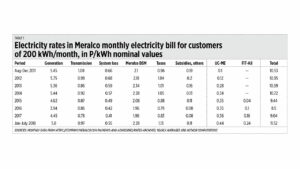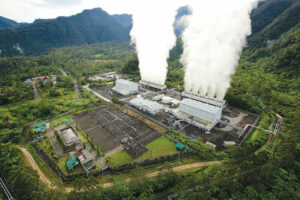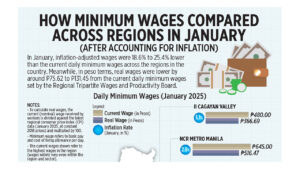On the ERC rates reset and nuclear energy

Last week, on Feb. 3, the House Committee on Energy held a public hearing about a Meralco refund and an investigation on the absence of a rate reset in the last decade for Meralco and the National Grid Corp. of the Philippines (NGCP).
The main issues were previously reported here: “ERC amends resolution to keep Meralco regulatory reset on track” (BusinessWorld, Dec. 29, 2024), “Senate bill extending Meralco franchise OK’d on 2nd reading” (BusinessWorld, Jan. 29), and “Meralco to refund P19 billion to consumers” (Philippine Star, Jan. 29).
This column and reactions in BusinessWorld also discussed the same topic two years ago: “Low power supply and Meralco distribution cost” (April 3, 2023), “Response to Bienvenido S. Oplas, Jr.’s April 3 piece, ‘Low power supply and Meralco distribution cost’,” by Alfredo Non (April 7, 2023), “More on Meralco distribution charges and energy transition” (April 13, 2023).
The representatives at the House Committee hearing last week focused their questions on former Energy Regulatory Commission (ERC) Commissioner Alfredo Non, who led the ERC for seven years (July 2011 to July 2018) when the scheduled fourth reset was not made. He said, among others, that the reset computation is very complicated, and a correction was needed in the third reset.
So far Meralco has refunded P48 billion to the consumers and is scheduled to refund another P19 billion. Public assumption was that Meralco’s distribution rate was bloated but when I checked the numbers from 2011 to 2018, this is not the case.
I checked the Meralco website and disaggregated the total charges from August 2011 to July 2018. I chose this period because this is the time that Mr. Non was ERC Commissioner, and he had oversight function for Universal Charge in Missionary Electrification (UC-ME) and Feed-in Tariff Allowance (FIT-All). UC-ME is a subsidy to customers of off-grid islands and provinces while FIT-All is subsidy to renewable energy (RE) companies that provide intermittent power like solar and wind under the RE law of 2008 (RA 9513).
I found that the generation rate by generation companies (gencos), the NGCP’s transmission rate, Meralco’s distribution-supply-metering (DSM) rate, system loss, government taxes, and subsidies to lifeline customers were generally flat over those seven years.
But the UC-ME rate increased significantly, from only 10 centavos in 2011 to 44 centavos in 2018; and the FIT-All rate increased from four centavos in 2015 to 24 centavos in 2018 (see Table 1).
So three narratives are debunked or belied by the above numbers. The first being that electricity prices “keep rising,” since the prices in 2016-2017 were even lower than the prices in 2011-2012. Secondly, that gencos of conventional power plants like coal and gas, the NGCP, and private distribution utilities like Meralco are to blame for the refund — which is a far out idea. And third, that the ERC leadership in that period were blameless — it was they, especially Mr. Non, that allowed the big jump in the UC-ME and FIT-All.
RPA ENERGY LECTUREAlso last week, on Feb. 7, the 3rd Ruperto P. Alonzo (RPA) Annual Memorial Lecture was held at the UP School of Economics (UPSE) in Diliman, Quezon City. The lecture, organized by the UPSE Program in Development Economics Alumni Association (PDEAA), was titled “Energy Trilemma: An Analysis of Philippines Situation.”
The four speakers were House Committee on Nuclear Energy Chairperson Representative Mark Cojuangco, Department of Energy Undersecretary Rowena Guevarra, ACEN President Eric Francia, and Institute of Climate and Sustainable Cities Advisor Albert Dalusung. It was moderated well by energy lawyer Jay Layug. I will discuss in another column the discussions that afternoon. For now I want to highlight the potential role of nuclear energy in helping reduce inflation.
Countries with a declining share of nuclear power over total generation from 2003 to 2023 have experienced generally high or rising inflation rates, and vice versa. Significant declines in nuclear/total generation were seen in Sweden, the UK, Germany, and Japan and their inflation rates increased.
In contrast, Asian nations that have a generally flat share of nuclear/total generation, or have increased it over the same period have experienced low or declining inflation rates — like China, India, South Korea, and the United Arab Emirates (see Table 2).
Mr. Cojuangco is correct in consistently and passionately advocating that the Philippines resume the operation of the nuclear plant in Bataan, and the construction of large nuclear plants in Pangasinan and other provinces in the country.
Meanwhile PDEAA officers and organizers want to thank the following who gave donations for the alumni homecoming that followed after the RPA lecture. Donations, mostly in kind, were used for raffle prizes and giveaways: Ferdinand Constantino, Jack Teotico of Galerie Joaquin, Aboitiz Power, GSIS, Meralco, the Metrobank Foundation, and Robinsons Retail. Thank you.
Bienvenido S. Oplas, Jr. is the president of Bienvenido S. Oplas, Jr. Research Consultancy Services, and Minimal Government Thinkers. He is an international fellow of the Tholos Foundation.




